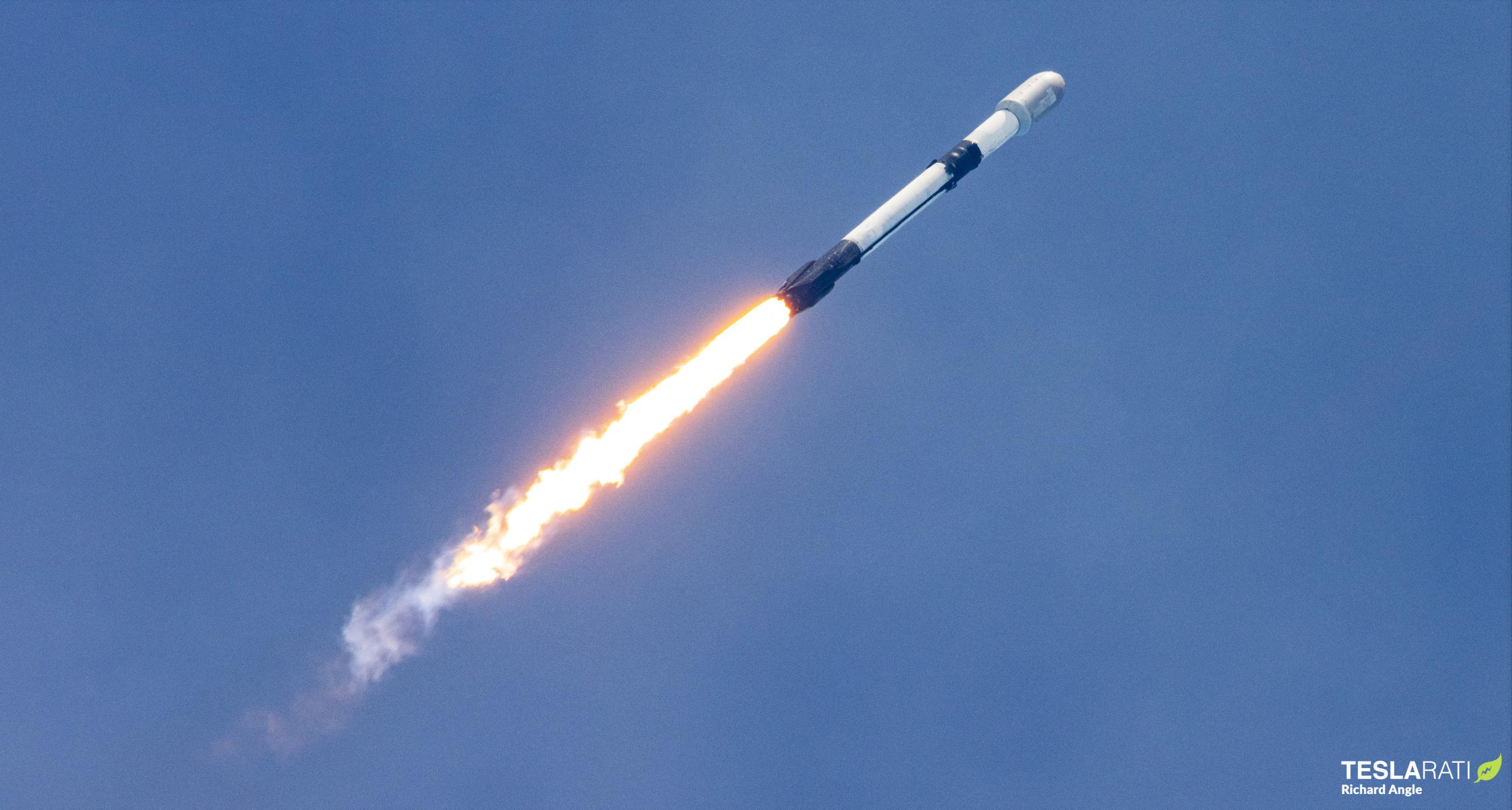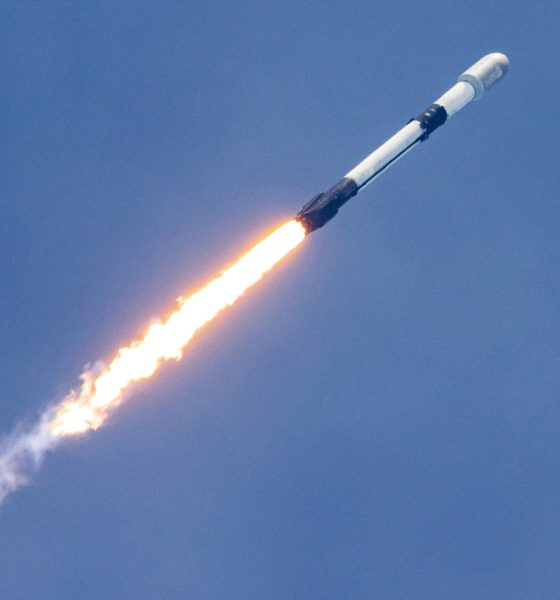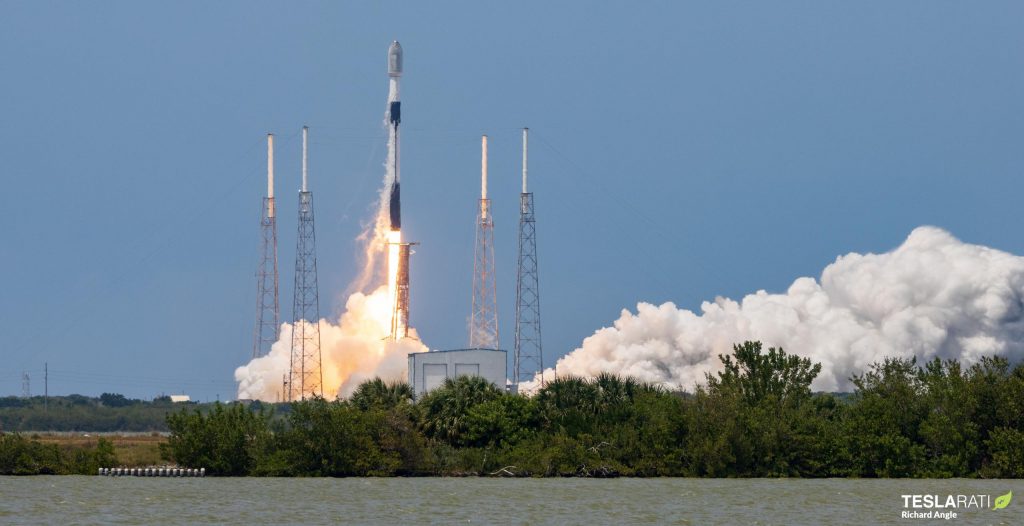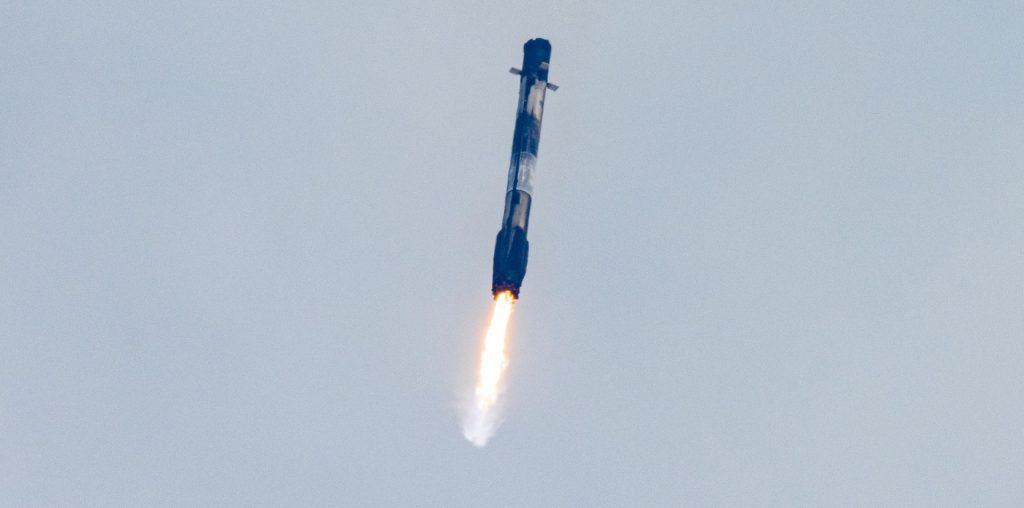

News
SpaceX delivers 59 spacecraft to orbit on fifth flawless rideshare launch
Update: After a slight eight-minute delay, SpaceX has successfully launched its fifth dedicated ‘Transporter’ rideshare mission, carrying 59 different spacecraft into a sun-synchronous orbit (SSO).
Following the Falcon 9 upper stage’s initial deployment of 39 different spacecraft, two of the deployed spacecraft will deploy another 20 or so small satellites over the next several weeks. Around an hour and a half after liftoff, SpaceX finally announced that the final Transporter-5 payload deployment was complete, confirming that the mission was a total success.
Falcon 9 booster B1061 performed as expected, acing its second Transporter launch in a row and eighth launch and landing overall since November 2020. Transporter-5 was SpaceX’s fifth launch this month and 22nd launch this year, representing an average of one launch every 6.5 days since the start of 2022. If SpaceX is able to complete four launches in June, it will be exactly half of the way to achieving 52 launches – an average of one launch per week – in a single calendar year.


SpaceX appears to be on track to launch its fifth dedicated Falcon 9 rideshare mission as early as 2:27 pm EDT (18:27 UTC) on Wednesday, May 25th, carrying a wide variety of interesting payloads into Earth orbit.
SpaceX has reportedly assigned Falcon 9 B1061 to the mission and Transporter-5 will be its eight launch and landing attempt since November 2020 and third launch this year. While of no particular consequence, B1061 will also become the first Falcon 9 booster to launch two Transporter missions back to back after supporting Transporter-4 less than two months ago. Falcon 9 is scheduled to lift off from SpaceX’s Cape Canaveral Space Force Station (CCSFS) LC-40 facilities and boost the Transporter-5 payload and upper stage most of the way out of the atmosphere, while the booster will return back to the Florida coast to land on a concrete pad just a few miles to the south.
Like Transporter-4, which launched with just 40 deployable payloads on April 1st, Transporter-5 appears to be another very small rideshare mission relative to SpaceX’s first three Transporter launches, demonstrating the company’s continued commitment to operating the service a bit like public transit. A public bus will still happily carry just a single passenger – efficiency, while important, comes second to dependability. For many of SpaceX’s individual Smallsat Program customers, that may help to alleviate some of the downsides of massive multi-dozen-satellite rideshares, which can often make individual customers feel forgotten and unimportant when they’re forced to swallow delays caused by payloads other than their own.


Based on official information provided by SpaceX on May 24th, Falcon 9 is scheduled to deploy only 39 payloads during Transporter-5. However, the real number of satellites deployed during the mission will likely be a bit higher due to the presence of three or four different vehicles that are designed to host or carry some of those payloads to different orbits. Spaceflight’s ‘Sherpa-AC1’ won’t have significant propulsion but it will carry several hosted payloads (‘hosted’ in the sense that the payload is not a free-flying satellite of its own) after deploying from Falcon 9.
The other two or three are true orbital transfer vehicles (OTVs), meaning that they have some kind of propulsion and are designed to deploy smaller satellites in customized orbits. The ultimate goal of the many startups trying to develop high-performance OTVs is to extract the best of both worlds from large rideshare missions and small rockets, combining ultra-cheap prices and orbits that are heavily optimized for each payload. Transporter-5 may carry Exolaunch’s “Reliant” OTV (unconfirmed) but is definitively scheduled to launch with D-Orbit’s “ION SCV-006” OTV and startup Momentus Space’s first ‘Vigoride’ OTV. Vigoride carries the unique distinction of being propelled by a first-of-its-kind “microwave electrothermal thruster” that turns water into a superheated plasma propellant.
Vigoride’s first true launch will be treated mainly as a test flight but it will also carry up to eight different small satellites. D-Orbit’s ION OTV only has one confirmed satellite on its manifest but will likely launch with at least a few more. All told, the number of satellites deployed as a result of Transporter-5 will likely be closer to 50 – a decent improvement over Transporter-4.
Several of those 50 or so payloads are particularly intriguing. Momentus Space’s first Vigoride OTV, if successful, could pave the way for the most capable commercial space tug currently available, with up to 2000 meters per second of delta V (dV) – a way to measure the stamina of rocket propulsion. NASA has also manifested its small Terabyte InfraRed Delivery (TBIRD) technology demonstrater satellite on Transporter-5 and will attempt to prove that it’s possible to use small, high-power lasers as extremely high-bandwidth downlinks. NASA hopes the tiny satellite will be able to transmit at up to 200 gigabits per second (Gbps), allowing it to downlink terabytes of data during a single pass over an Earth-based ground station.
AISTECH Space will launch an Earth observation satellite prototype outfitted with a first-of-its-kind high-resolution thermal imager. Last but certainly not least, Nanoracks and Maxar are scheduled to launch the first of multiple planned demonstrations and technology maturation missions for in-space manufacturing and construction technologies. The hosted payload is relatively simple by many measures and will only operate for about an hour, but it aims to demonstrate the first structural metal cutting in space.
Parent company Voyager Space ultimately wants to use the expertise it gains from the ‘Outpost Program’ to convert expended rocket upper stages into orbital ‘Outposts’ that will host customer payloads and support the continued development of in-space harvesting, recycling, construction, and more.
As of 5 am EDT (09:00 UTC), SpaceX still hasn’t officially confirmed via Tweet or website update that Transporter-5 is ‘go’ for launch. If it is, an official webcast available here will likely begin around 2:10 pm EDT (18:10 UTC).

Elon Musk
Elon Musk’s X will start using a Tesla-like software update strategy
The initiative seems designed to accelerate updates to the social media platform, while maintaining maximum transparency.

Elon Musk’s social media platform X will adopt a Tesla-esque approach to software updates for its algorithm.
The initiative seems designed to accelerate updates to the social media platform, while maintaining maximum transparency.
X’s updates to its updates
As per Musk in a post on X, the social media company will be making a new algorithm to determine what organic and advertising posts are recommended to users. These updates would then be repeated every four weeks.
“We will make the new 𝕏 algorithm, including all code used to determine what organic and advertising posts are recommended to users, open source in 7 days. This will be repeated every 4 weeks, with comprehensive developer notes, to help you understand what changed,” Musk wrote in his post.
The initiative somewhat mirrors Tesla’s over-the-air update model, where vehicle software is regularly refined and pushed to users with detailed release notes. This should allow users to better understand the details of X’s every update and foster a healthy feedback loop for the social media platform.
xAI and X
X, formerly Twitter, has been acquired by Elon Musk’s artificial intelligence startup, xAI last year. Since then, xAI has seen a rapid rise in valuation. Following the company’s the company’s upsized $20 billion Series E funding round, estimates now suggest that xAI is worth tens about $230 to $235 billion. That’s several times larger than Tesla when Elon Musk received his controversial 2018 CEO Performance Award.
As per xAI, the Series E funding round attracted a diverse group of investors, including Valor Equity Partners, Stepstone Group, Fidelity Management & Research Company, Qatar Investment Authority, MGX, and Baron Capital Group, among others. Strategic partners NVIDIA and Cisco Investments also continued support for building the world’s largest GPU clusters.
News
Tesla FSD Supervised wins MotorTrend’s Best Driver Assistance Award
The decision marks a notable reversal for the publication from prior years, with judges citing major real-world improvements that pushed Tesla’s latest FSD software ahead of every competing ADAS system.

Tesla’s Full Self-Driving (Supervised) system has been named the best driver-assistance technology on the market, earning top honors at the 2026 MotorTrend Best Tech Awards.
The decision marks a notable reversal for the publication from prior years, with judges citing major real-world improvements that pushed Tesla’s latest FSD software ahead of every competing ADAS system. And it wasn’t even close.
MotorTrend reverses course
MotorTrend awarded Tesla FSD (Supervised) its 2026 Best Tech Driver Assistance title after extensive testing of the latest v14 software. The publication acknowledged that it had previously criticized earlier versions of FSD for erratic behavior and near-miss incidents, ultimately favoring rivals such as GM’s Super Cruise in earlier evaluations.
According to MotorTrend, the newest iteration of FSD resolved many of those shortcomings. Testers said v14 showed far smoother behavior in complex urban scenarios, including unprotected left turns, traffic circles, emergency vehicles, and dense city streets. While the system still requires constant driver supervision, judges concluded that no other advanced driver-assistance system currently matches its breadth of capability.
Unlike rival systems that rely on combinations of cameras, radar, lidar, and mapped highways, Tesla’s FSD operates using a camera-only approach and is capable of driving on city streets, rural roads, and freeways. MotorTrend stated that pure utility, the ability to handle nearly all road types, ultimately separated FSD from competitors like Ford BlueCruise, GM Super Cruise, and BMW’s Highway Assistant.
High cost and high capability
MotorTrend also addressed FSD’s pricing, which remains significantly higher than rival systems. Tesla currently charges $8,000 for a one-time purchase or $99 per month for a subscription, compared with far lower upfront and subscription costs from other automakers. The publication noted that the premium is justified given FSD’s unmatched scope and continuous software evolution.
Safety remained a central focus of the evaluation. While testers reported collision-free operation over thousands of miles, they noted ongoing concerns around FSD’s configurable driving modes, including options that allow aggressive driving and speeds beyond posted limits. MotorTrend emphasized that, like all Level 2 systems, FSD still depends on a fully attentive human driver at all times.
Despite those caveats, the publication concluded that Tesla’s rapid software progress fundamentally reshaped the competitive landscape. For drivers seeking the most capable hands-on driver-assistance system available today, MotorTrend concluded Tesla FSD (Supervised) now stands alone at the top.
News
Elon Musk’s Grokipedia surges to 5.6M articles, almost 79% of English Wikipedia
The explosive growth marks a major milestone for the AI-powered online encyclopedia, which was launched by Elon Musk’s xAI just months ago.

Elon Musk’s Grokipedia has grown to an impressive 5,615,201 articles as of today, closing in on 79% of the English Wikipedia’s current total of 7,119,376 articles.
The explosive growth marks a major milestone for the AI-powered online encyclopedia, which was launched by Elon Musk’s xAI just months ago. Needless to say, it would only be a matter of time before Grokipedia exceeds English Wikipedia in sheer volume.
Grokipedia’s rapid growth
xAI’s vision for Grokipedia emphasizes neutrality, while Grok’s reasoning capabilities allow for fast drafting and fact-checking. When Elon Musk announced the initiative in late September 2025, he noted that Grokipedia would be an improvement to Wikipedia because it would be designed to avoid bias.
At the time, Musk noted that Grokipedia “is a necessary step towards the xAI goal of understanding the Universe.”
Grokipedia was launched in late October, and while xAI was careful to list it only as Version 0.1 at the time, the online encyclopedia immediately earned praise. Wikipedia co-founder Larry Sanger highlighted the project’s innovative approach, noting how it leverages AI to fill knowledge gaps and enable rapid updates. Netizens also observed how Grokipedia tends to present articles in a more objective manner compared to Wikipedia, which is edited by humans.
Elon Musk’s ambitious plans
With 5,615,201 total articles, Grokipedia has now grown to almost 79% of English Wikipedia’s article base. This is incredibly quick, though Grokipedia remains text-only for now. xAI, for its part, has now updated the online encyclopedia’s iteration to v0.2.
Elon Musk has shared bold ideas for Grokipedia, including sending a record of the entire knowledge base to space as part of xAI’s mission to preserve and expand human understanding. At some point, Musk stated that Grokipedia will be renamed to Encyclopedia Galactica, and it will be sent to the cosmos.
“When Grokipedia is good enough (long way to go), we will change the name to Encyclopedia Galactica. It will be an open source distillation of all knowledge, including audio, images and video. Join xAI to help build the sci-fi version of the Library of Alexandria!” Musk wrote, adding in a later post that “Copies will be etched in stone and sent to the Moon, Mars and beyond. This time, it will not be lost.”








